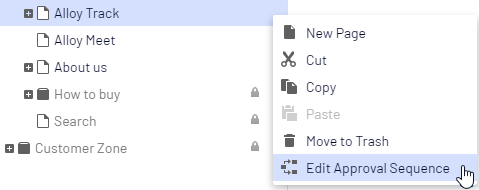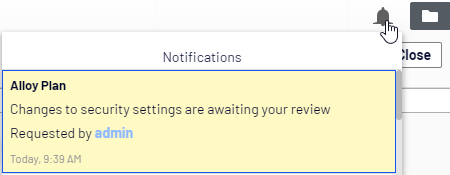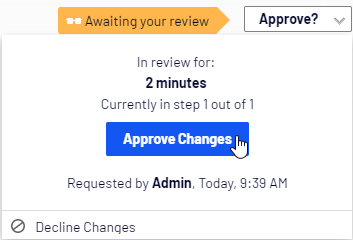 Change approvals
Change approvals
Change approvals is an add-on to Optimizely CMS, which lets you make sure that certain actions that affect the website structure or content are reviewed and approved before they are applied. The actions that can go through change approvals are changes to access rights, language settings for fallback and replacement languages, and expiration date, and also the moving of pages and assets such as blocks, images, and media in the structure.
Change approvals are not triggered when a page is moved but remains under the same parent page, that is, when the page is moved only to change the sort order.
Change approvals is similar to Content approvals, which is a feature where the content must be reviewed and approved before it can be published. You cannot use Change approvals without Content approvals. Both features use the same approval sequences, which means that the same reviewers approve changes to both content and to settings such as access rights, language settings, and so on.
The Optimizely Digital Experience Platform contains many features to support you in your daily work. Depending on how your solution is set up, some features described in this documentation may not be available to you. Contact your system administrator to find out more. See Optimizely World for technical information.
How it works
Change approvals are done by setting up a content approval sequence which defines the reviewers. An approval sequence can be set up with any number of approval steps and any number of reviewers in each step. The sequence is set up by an administrator; as described in Managing approval sequences.
When an approval sequence has been defined, the approval process is started as soon as a user performs one of the actions that triggers the Change approvals. Once the process is started, the change must be approved or declined (or the review request canceled) before any other change that requires approval can be done.
As soon as one of the reviewers in a step approves the change, that step is considered completed and the reviewers in the next step of the sequence are notified that they have a change to review. When all steps in the approval sequence have been approved, the change is immediately applied.
Tina has been asked to change the order of the products in the Alloy top navigation menu. Since the navigation menu order is controlled by the order of the pages in the page tree, she moves the Alloy Track page in the page tree. The Alloy Track page has an approval sequence defined so the page is not immediately moved, and Tina sees a message that the move of the page is awaiting approval. The approval sequence is set up with one step, and both reviewers, Alicia and Carlos, are notified in the user interface when they log in that Tina has moved Alloy Track and that they need to approve that move. Carlos now approves the move and the page is moved immediately and the top navigation menu is updated on the website. If Carlos had instead declined, the page would have remained in its original position.
Setting up an approval sequence
Change approvals use the same approval sequences as Content approvals. This means that if you have set a content approval sequence for a content item, the same sequence and the same reviewers, are used when action controlled by the Change approvals feature is performed on that content item. How to set up content approval sequences are described in detail in Managing approval sequences.
The approval sequence overview is opened from a page's or assets folder's context menu:

When setting up an approval sequence, there is a language setting  . This setting only applies to Content approvals, where it is possible to set up different reviewers for different languages. Change approvals does not take this setting into consideration; all appointed reviewers can approve changes in all languages.
. This setting only applies to Content approvals, where it is possible to set up different reviewers for different languages. Change approvals does not take this setting into consideration; all appointed reviewers can approve changes in all languages.
As an editor or administrator, how does Change approvals affect me?
If you have the access rights to change one of the settings controlled by the Change approval functionality, you can change settings or move pages and blocks the same way as without Change approvals. However, after changing the setting, you will see a notification message: Your changes have been saved and sent for approval. The changes will come into effect once they have been approved. There is also a notification bar in the content item to inform you that a change is in review.

Once a change has been made and it is in review, you can no longer move the item or edit a setting that requires approval until the review request has been approved, declined, or canceled. You can cancel the review, and thereby revert your change, by selecting Cancel review request from the Options menu.
As soon as the last of the appointed reviewers approves the change, the change automatically comes into effect.
As a reviewer, how do I approve or decline a change?
Depending on how the approval sequence has been set up, you may not be allowed to approve or decline a change you have made yourself, even you are one of the appointed reviewers.
- When you log in to the Optimizely CMS user interface, you will see a notification if you have a change to approve:

- Click this notification to see the change detail overview:

In this view, you can see the old value of the setting and the new value. Greyed out values have not been touched; bold are used for new values, and strike-through for removed values.
- To approve or decline this change, click the Options menu and select Approve Changes or Decline Changes:

Change approvals does not check if the reviewer has the access rights to perform the proposed change. It only checks if the user who makes the change has the access rights. For example, if you remove the 'Everyone' access rights to a page, Change approvals checks that you have the right to do so, but the reviewer who approves the change does not have to have that right.
Email notifications for change approvals have not yet been implemented, so you are only notified in the user interface when you have a change to review.
Using Content approvals and Change approvals at the same time
When you have used Content approvals and sent content for review, the content (that is, the specific version of the content) is locked for editing. You can still move the page/block and change the language settings. You cannot change the access rights or expiration date.
When you have used Change approvals and sent a change for review, you can still edit the content but you cannot move the page/block or change language settings, access rights, or expiration date.
